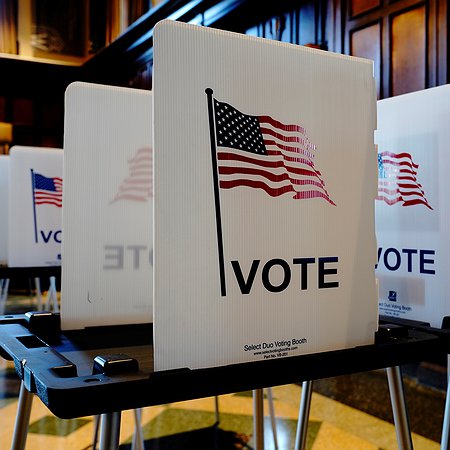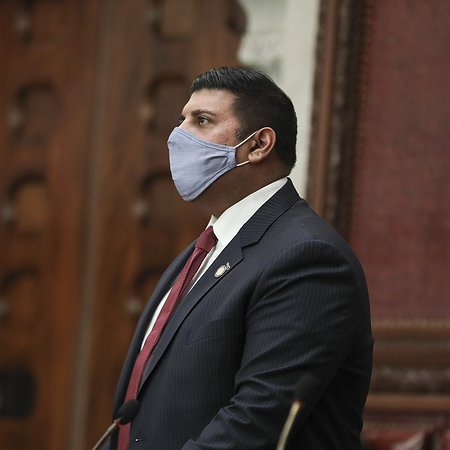Hochul Once Again Lies To Public About Bail Proposal
Gov. Kathy Hochul lied to the public about bail reform again in a press conference this week, falsely claiming that her proposal to remove the “least restrictive means” standard is backed up by data and that an “inconsistency” currently exists within the bail laws.
The Briefing

Gov. Kathy Hochul lied to the public about bail reform again in a press conference this week, falsely claiming that her proposal to remove the “least restrictive means” standard is backed up by data and that an “inconsistency” currently exists within the bail laws. In fact, authors of a recent study on bail reform not-so-subtly rejected Hochul’s proposal, and there is no “inconsistency” found in a section of the bail law that has existed for decades.
Hochul’s proposal is not supported by data
In her press conference, Hochul claimed that recently-released data from John Jay College supports her proposal to remove the least restrictive means standard, because there was an increase in rearrests for people charged with violent felonies. The governor is wrong: the report explicitly rejects this argument.
The report’s authors conclusively state that bail reform reduced recidivism for misdemeanors and low-level felony crimes. However, for bail eligible cases (like the violent felonies Hochul references), reducing the use of bail did not affect recidivism. Crucially, neither did requiring judges to use the “least restrictive means” standard that Hochul wants to eliminate. In other words, a key piece of support for Hochul’s proposal is incorrect. The “least restrictive means” standard is not tied to recidivism. Hochul claims the data is on her side. But even a cursory review of the top-line takeaways from the John Jay report illustrates that she is wrong.
The authors of the John Jay report go on to not-so-implicitly reject Hochul’s contention that the “least restrictive means” standard is a public safety issue.
“We are not embracing weaker decision-making standards that might compromise due process, undermine the presumption of innocence, or contradict legal precedents concerning when bail or pretrial detention are permissible,” the authors write, clearly referencing the “least restrictive means” standard that has been New York law for decades.
Finally, the authors recommend that policymakers avoid additional tweaks to the bail reform law because studies tracking longer periods of time are necessary to determine the public safety effect of reducing the use of bail in bail eligible cases.
The governor also handpicked misleading data for her press conference. Hochul pointed to the increase of the raw number of people who have been rearrested for violent felonies since bail reform was enacted. But she fails to note that the amount of crime is higher (bail reform has no connection to any increase in crime) as well, meaning that the raw number of people who didn’t get rearrested has increased, too.
A better way to determine whether bail reform has had any effect on recidivism is to look at the percentage of people who are re-arrested after being arrested for a violent felony. Over the past four years, from before bail reform until 2022, that number is remarkably stable. The almost exact same percentage of people charged with a violent felony are rearrested now as they were before 2020. So despite massive changes in bail laws and numerous rollbacks, rearrest numbers are the same. This isn’t a revelation; study after study tells us the same thing. Hochul knows that bail reform has no effect on recidivism as well, but chooses to ignore the facts.
There is no “inconsistency” in the law
Hochul continues to try to justify her proposal with reasoning that makes no sense and confuses New Yorkers. On Wednesday, she claimed an inconsistency in the law exists because one part of the law says a judge should use the least restrictive conditions to ensure someone’s appearance at future court dates, and another part of the law sets out the factors a judge can consider when making a bail decision, such as the charges and alleged harm caused, criminal history, past violations of court orders, flight risk, past gun use and possession, and more.
This is not an inconsistency, nor is it confusing. In fact, these two supposedly “confusing” parts of the law are right next to each other in the written legislation. One aspect of the law is the overarching legal standard judges base their decisions on. The other aspect of the law spells out the factors judges consider, while making a decision consistent with the overarching legal standard.
Imagine you are going to buy a car. The reason you want to buy a car is that you want to be able to drive to the mountains to ski. This is your “standard.” When you go to the dealership, you’ll look at a number of features for each car you are considering — its horsepower, its safety rating, its off-road ability, its capacity, how you might store your skis – in order to find that car that aligns with your standard. These are your “factors.” It would be very difficult to make sense of the factors without a broader standard.
Hochul is proposing that you forget about the initial reason you want to buy the car — to go to the mountains — and arbitrarily buy a car based on some unknown feeling about the car’s features. This makes no sense – a standard is necessary to make sense of the factors. Without a standard, the factors are unrelated pieces of information.
No matter how many times Hochul claims judges are confused, it is clear judges know which alleged crimes are eligible for bail, what the legal standard is to base their decision on, and which factors to consider in making a determination. They have said so on multiple occasions.
Hochul is not listening to New Yorkers
Legislative leaders and New Yorkers know the truth – bail reform is a massive success that protects freedom and public safety. Instead of listening to facts, Hochul is now soliciting support from former New York City mayor Mike Bloomberg, whose law enforcement policies were so racist, a federal judge declared them unconstitutional. Hochul could listen to New Yorkers; instead she is playing politics with their lives.
Story Link
Press release and video of Hochul's press confernence








